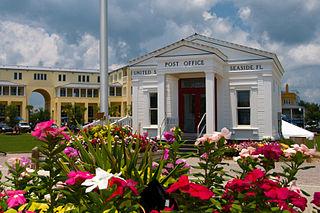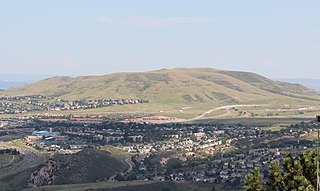Related Research Articles

Smart growth is an urban planning and transportation theory that concentrates growth in compact walkable urban centers to avoid sprawl. It also advocates compact, transit-oriented, walkable, bicycle-friendly land use, including neighborhood schools, complete streets, and mixed-use development with a range of housing choices. The term "smart growth" is particularly used in North America. In Europe and particularly the UK, the terms "compact city", "urban densification" or "urban intensification" have often been used to describe similar concepts, which have influenced government planning policies in the UK, the Netherlands and several other European countries.

New Urbanism is an urban design movement that promotes environmentally friendly habits by creating walkable neighbourhoods containing a wide range of housing and job types. It arose in the United States in the early 1980s, and has gradually influenced many aspects of real estate development, urban planning, and municipal land-use strategies. New Urbanism attempts to address the ills associated with urban sprawl and post-Second World War suburban development.

Pedestrian zones are areas of a city or town reserved for pedestrian-only use and in which most or all automobile traffic is prohibited. Converting a street or an area to pedestrian-only use is called pedestrianisation.

Urban sprawl is defined as "the spreading of urban developments on undeveloped land near a city". Urban sprawl has been described as the unrestricted growth in many urban areas of housing, commercial development, and roads over large expanses of land, with little concern for urban planning. In addition to describing a special form of urbanization, the term also relates to the social and environmental consequences associated with this development. Medieval suburbs suffered from the loss of protection of city walls, before the advent of industrial warfare. Modern disadvantages and costs include increased travel time, transport costs, pollution, and destruction of the countryside. The cost of building urban infrastructure for new developments is hardly ever recouped through property taxes, amounting to a subsidy for the developers and new residents at the expense of existing property taxpayers.

The car-free movement is a broad, informal, emergent network of individuals and organizations, including social activists, urban planners, transportation engineers, environmentalists and others, brought together by a shared belief that large and/or high-speed motorized vehicles are too dominant in most modern cities. The goal of the movement is to create places where motorized vehicle use is greatly reduced or eliminated, by converting road and parking space to other public uses and rebuilding compact urban environments where most destinations are within easy reach by other means, including walking, cycling, public transport, personal transporters, and mobility as a service.

Downtown Portland is the central business district of Portland, Oregon, United States. It is on the west bank of the Willamette River in the northeastern corner of the southwest section of the city and where most of the city's high-rise buildings are found.

In urban planning, infill, or in-fill, is the rededication of land in an urban environment, usually open-space, to new construction. Infill also applies, within an urban polity, to construction on any undeveloped land that is not on the urban margin. The slightly broader term "land recycling" is sometimes used instead. Infill has been promoted as an economical use of existing infrastructure and a remedy for urban sprawl. Its detractors view it as overloading urban services, including increased traffic congestion and pollution, and decreasing urban green-space. Many also detract it for social and historical reasons, partly due to its unproven effects and its similarity with gentrification.

Mixed use is a type of urban development, urban design, urban planning and/or a zoning classification that blends multiple uses, such as residential, commercial, cultural, institutional, or entertainment, into one space, where those functions are to some degree physically and functionally integrated, and that provides pedestrian connections. Mixed-use development may be applied to a single building, a block or neighborhood, or in zoning policy across an entire city or other administrative unit. These projects may be completed by a private developer, (quasi-) governmental agency, or a combination thereof. A mixed-use development may be a new construction, reuse of an existing building or brownfield site, or a combination.

Greyfield land is underused real estate assets or land. The term was first coined in the UK in urban design theory in the late 1990s, and later adopted in the US about a decade later, with the name coming from the "sea" of empty asphalt concrete that often accompanies these sites. The word greyfield is a relative neologism as compared to more commonly known terms such as brownfield and greenfield.

A transit village is a pedestrian-friendly mixed-use district or neighborhood oriented around the station of a high-quality transit system, such as rail or B.R.T. Often a civic square of public space abuts the train station, functioning as the hub or centerpiece of the surrounding community and encouraging social interaction. While mainly residential in nature, many transit villages offer convenience retail and services to residents heading to and from train stations.

The City Creek Center (CCC) is a mixed-use development with an upscale open-air shopping center, office and residential buildings, fountain, and simulated creek near Temple Square in downtown Salt Lake City, Utah, United States. It is an undertaking by Property Reserve, Inc. (PRI), the commercial real estate division of the Corporation of the President of The Church of Jesus Christ of Latter-day Saints and Taubman Centers, Inc. (TCI). The CCC integrates shopping and residential elements, with foliage-lined walkways and streams covering two blocks in the heart of downtown Salt Lake. PRI invested in the housing and parking elements of the mall, while TCI owns and operates the shopping center itself. The CCC opened to the general public on March 22, 2012. This shopping, office, and residential center encompass nearly 20 acres (8.1 ha) of downtown Salt Lake City. The City Creek Center is part of an estimated $5 billion sustainable design project to revitalize downtown Salt Lake City. The CCC project itself has been estimated to cost around $1.5 billion.

Easton Town Center is a shopping center and mall in northeast Columbus, Ohio, United States. Opened in 1999, the core buildings and streets that comprise Easton are intended to look like a self-contained town, reminiscent of American towns and cities in the early-to-mid 20th century. Included in the design are fountains, streets laid out in a grid pattern surrounded by a continuous loop, and metered storefront parking.

Brickell City Centre is a large mixed-use complex consisting of two residential high-rise towers, two office buildings, a high-rise hotel, and an interconnected five-story shopping mall and lifestyle center covering 9 acres (36,000 m2) located in the Brickell district of Downtown Miami, Florida. Situated at the junction of Miami Avenue and Eighth Street, it spans up to five blocks to the west of Brickell Avenue and to the south of the Miami River. Contrary to the name, the development is not in the traditional downtown Miami city centre, but in the more recently redeveloped financial district of Brickell. The retail shopping and lifestyle center is operated by Simon Malls.


River Park Square is a shopping mall and entertainment complex in Spokane, Washington. The shopping center was originally opened in 1974. Following years of decline, the center was redeveloped in 1999 using public and private funds in an effort to revitalize downtown Spokane. The mall, still privately owned by Cowles Company, is anchored by Nordstrom and contains an outpost of AMC Theatres.

Lakewood is the home rule municipality that is the most populous municipality in Jefferson County, Colorado, United States. The city population was 155,984 at the 2020 U.S. Census, making Lakewood the fifth most populous city in Colorado and the 167th most populous city in the United States. Lakewood is a suburb of Denver and is a principal city of the Denver–Aurora–Lakewood, CO Metropolitan Statistical Area and a major city of the Front Range Urban Corridor.

Redlands Mall was a mall in Redlands, California with two anchors, CVS Pharmacy and Gottschalks. The mall, located on about 12 acres on Orange Street and Eureka Street between Redlands Boulevard and Citrus Avenue, was built in 1977. The mall permanently closed in 2010.

South Bay is a shopping center in the Dorchester neighborhood of Boston, Massachusetts. It is located off I-93, US 1, Route 3, near the transition from the Southeast Expressway to the Central Artery traveling through Downtown Boston.
Valley Plaza was a shopping center in North Hollywood, Los Angeles, one of the first in the San Fernando Valley, opened in 1951. In the mid-1950s it was reported to be the largest shopping center on the West Coast of the United States and the third-largest in the country. It was located along Laurel Canyon Boulevard from Oxnard to Vanowen, and west along Victory Boulevard. Like its competitor Panorama City Shopping Center to the north, Valley Plaza started with one core development and grew over time to market, under the single name "Valley Plaza", a collection of adjacent retail developments with multiple developers, owners, and opening dates.
Culdesac Tempe is a car-free mixed-use development in Tempe, Arizona which opened in 2023.
References
- ↑ "Retrofitting Suburbia" . Retrieved July 5, 2023.
- ↑ "The State of the art of suburban retrofit" . Retrieved July 5, 2023.
- ↑ "Belmar Lake Wood, Colorado – From dead mall to downtown" . Retrieved July 5, 2023.
- ↑ Steuteville, Robert (October 8, 2019). "Malls to mixed-use centers and other opportunities" . Retrieved July 5, 2023.